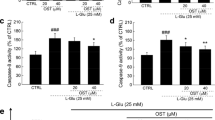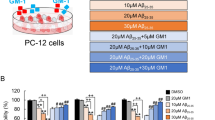Abstract
Recent literature suggested an important function of native amyloid precursor protein (APP) as amine oxidase implicating in protection of brain cells from catecholamine-induced toxicity. However, any role of catecholamines on regulation of native APP has not been explored. Here we report that dopamine (DA), one of the most prominent catecholamine neurotransmitters in brain, down-modulates native APP protein in several neuronal cell types. Using SH-SY5Y cells as model, we detected no alteration of transcript expression and unaffected translation suggested that DA might induce APP degradation. We actually found that DA treatment decreased the stability of APP. Lysosomal blockers inhibited DA-induced APP degradation, but specific proteasomal blocker failed to do so. We detected the role of cathepsin B in DA-induced APP degradation by using pharmacological inhibitor and specific siRNA. We also revealed that DA could increase cathepsin B expression at both transcript and protein levels. Using antioxidant N-acetyl cysteine, we detected increased level of reactive oxygen species generation that was found responsible for induced cathepsin B expression by DA and resultant APP degradation. Our study reveals the existence of reciprocal regulation of a catecholamine and an amine oxidase implicating in brain catecholamine homeostasis.







Similar content being viewed by others
References
Gralle M, Ferreira ST (2007) Structure and functions of the human amyloid precursor protein: the whole is more than the sum of its parts. Prog Neurobiol 82:11–32. https://doi.org/10.1016/j.pneurobio.2007.02.001 (2007)
Mattson MP (1997) Cellular actions of beta-amyloid precursor protein and its soluble and fibrillogenic derivatives. Physiol Rev 77:1081–1132. https://doi.org/10.1152/physrev.1997.77.4.1081
El Ayadi A, Stieren ES, Barral JM, Boehning D (2012) Ubiquilin-1 regulates amyloid precursor protein maturation and degradation by stimulating K63-linked polyubiquitination of lysine 688. Proc Natl Acad Sci USA 109:13416–13421. https://doi.org/10.1073/pnas.1206786109 (2012)
Chow VW, Mattson MP, Wong PC, Gleichmann M (2010) An overview of APP processing enzymes and products. Neuromolecular Med 12:1–12. https://doi.org/10.1007/s12017-009-8104-z (2010)
Walter J, Haass C (2000) Posttranslational modifications of amyloid precursor protein: ectodomain phosphorylation and sulfation. Methods Mol Med 32:149–168. https://doi.org/10.1385/1-59259-195-7:149
Duce JA, Ayton S, Miller AA, Tsatsanis A, Lam LQ, Leone L, Corbin JE, Butzkueven H, Kilpatrick TJ, Rogers JT, Barnham KJ, Finkelstein DI, Bush AI (2013) Amine oxidase activity of beta-amyloid precursor protein modulates systemic and local catecholamine levels. Mol Psychiatr 18:245–254. https://doi.org/10.1038/mp.2011.168 (2013)
Vallone D, Picetti R, Borrelli E (2000) Structure and function of dopamine receptors. Neurosci Biobehav Rev 24:125–132
Bjorklund A, Dunnett SB (2007) Dopamine neuron systems in the brain: an update. Trends Neurosci 30:194–202. https://doi.org/10.1016/j.tins.2007.03.006 (2007)
Van den Heuvel DM, Pasterkamp RJ (2008) Getting connected in the dopamine system. Prog Neurobiol 85:75–93. https://doi.org/10.1016/j.pneurobio.2008.01.003 (2008)
Chinta SJ, Andersen JK (2005) Dopaminergic neurons. Int J Biochem Cell Biol 37:942–946. https://doi.org/10.1016/j.biocel.2004.09.009 (2005)
Bozzi Y, Borrelli E (2006) Dopamine in neurotoxicity and neuroprotection: what do D2 receptors have to do with it? Trends Neurosci 29:167–174. https://doi.org/10.1016/j.tins.2006.01.002 (2006)
Iversen SD, Iversen LL (2007) Dopamine: 50 years in perspective. Trends Neurosci 30:188–193. https://doi.org/10.1016/j.tins.2007.03.002 (2007)
Tanaka S, Shiojiri S, Takahashi Y, Kitaguchi N, Ito H, Kameyama M, Kimura J, Nakamura S, Ueda K (1989) Tissue-specific expression of three types of beta-protein precursor mRNA: enhancement of protease inhibitor-harboring types in Alzheimer’s disease brain. Biochem Biophys Res Commun 165:1406–1414
Dahlstrom A, Fuxe K (1964) Localization of monoamines in the lower brain stem. Experientia 20:398–399
Priller C, Bauer T, Mitteregger G, Krebs B, Kretzschmar HA, Herms J (2006) Synapse formation and function is modulated by the amyloid precursor protein. J Neurosci 26:7212–7221. https://doi.org/10.1523/JNEUROSCI.1450-06.2006 (2006)
Storey E, Beyreuther K, Masters CL (1996) Alzheimer’s disease amyloid precursor protein on the surface of cortical neurons in primary culture co-localizes with adhesion patch components. Brain Res 735:217–231
Storey E, Spurck T, Pickett-Heaps J, Beyreuther K, Masters CL (1996) The amyloid precursor protein of Alzheimer’s disease is found on the surface of static but not activity motile portions of neurites. Brain Res 735:59–66
Esler M, Jennings G, Lambert G, Meredith I, Horne M, Eisenhofer G (1990) Overflow of catecholamine neurotransmitters to the circulation: source, fate, and functions. Physiol Rev 70:963–985. https://doi.org/10.1152/physrev.1990.70.4.963
Galli A, Blakely RD, DeFelice LJ (1998) Patch-clamp and amperometric recordings from norepinephrine transporters: channel activity and voltage-dependent uptake. Proc Natl Acad Sci U S A 95:13260–13265
Dev S, Kumari S, Singh N, Kumar Bal S, Seth P, Mukhopadhyay CK (2015) Role of extracellular Hydrogen peroxide in regulation of iron homeostasis genes in neuronal cells: Implication in iron accumulation. Free Radic Biol Med 86:78–89. https://doi.org/10.1016/j.freeradbiomed.2015.05.025 (2015)
Biswas S, Gupta MK, Chattopadhyay D, Mukhopadhyay CK (2007) Insulin-induced activation of hypoxia-inducible factor-1 requires generation of reactive oxygen species by NADPH oxidase. Am J Physiol Heart Circ Physiol 292:H758–H766. https://doi.org/10.1152/ajpheart.00718.2006 (2007)
Cagnin M, Ozzano M, Bellio N, Fiorentino I, Follo C, Isidoro C (2012) Dopamine induces apoptosis in APPswe-expressing Neuro2A cells following Pepstatin-sensitive proteolysis of APP in acid compartments. Brain Res 1471:102–117. https://doi.org/10.1016/j.brainres.2012.06.025 (2012)
Haass C, Koo EH, Mellon A, Hung AY, Selkoe DJ (1992) Targeting of cell-surface beta-amyloid precursor protein to lysosomes: alternative processing into amyloid-bearing fragments. Nature 357:500–503. https://doi.org/10.1038/357500a0 (1992)
Segura-Aguilar J, Paris I, Munoz P, Ferrari E, Zecca L, Zucca FA (2014) Protective and toxic roles of dopamine in Parkinson’s disease. J Neurochem 129:898–915. https://doi.org/10.1111/jnc.12686 (2014)
Linert W, Herlinger E, Jameson RF, Kienzl E, Jellinger K, Youdim MB (1996) Dopamine, 6-hydroxydopamine, iron, and dioxygen-their mutual interactions and possible implication in the development of Parkinson’s disease. Biochim Biophys Acta 1316:160–168
Carrillo-Mora P, Luna R, Colin-Barenque L (2014) Amyloid beta: multiple mechanisms of toxicity and only some protective effects? Oxid Med Cell Longev 2014:795375. https://doi.org/10.1155/2014/795375 (2014)
Hook G, Hook V, Kindy M (2011) The cysteine protease inhibitor, E64d, reduces brain amyloid-beta and improves memory deficits in Alzheimer’s disease animal models by inhibiting cathepsin B, but not BACE1, beta-secretase activity. J Alzheimers Dis 26:387–408. https://doi.org/10.3233/JAD-2011-110101 (2011)
Halliwell B (1992) Oxygen radicals as key mediators in neurological disease: fact or fiction? Ann Neurol 32 S10–S15
Haass C, Kaether C, Thinakaran G, Sisodia S (2012) Trafficking and proteolytic processing of APP. Cold Spring Harb Perspect Med 2:a006270. https://doi.org/10.1101/cshperspect.a006270 (2012)
Martorana A, Koch G (2014) “Is dopamine involved in Alzheimer’s disease?”. Front Aging Neurosci 6:252. https://doi.org/10.3389/fnagi.2014.00252 (2014)
Whittle N, Sartori SB, Dierssen M, Lubec G, Singewald N (2007) Fetal Down syndrome brains exhibit aberrant levels of neurotransmitters critical for normal brain development. Pediatrics 120:e1465–e1471. https://doi.org/10.1542/peds.2006-3448
Angelopoulou N, Souftas V, Sakadamis A, Matziari C, Papameletiou V, Mandroukas K (1999) Gonadal function in young women with Down syndrome. Int J Gynaecol Obstet 67:15–21
Acknowledgements
CKM acknowledges financial support received from Department of Biotechnology, India, and the National Initiative on Glial Cell Research in Health and Disease from Department of Biotechnology; Indian Council of Medical Research-CAR grant to SCMM; University with potential for excellence (UPE-II) to JNU and Department of Science and Technology-PURSE program to Jawaharlal Nehru University. SK was supported by fellowship from Department of Biotechnology, India; AM thanks DS Kothari postdoctoral fellowship from UGC.
Author information
Authors and Affiliations
Contributions
CKM conceived, designed, analyzed and coordinated the study and wrote the paper. SK conceived, designed, performed, analyzed experiments and wrote the paper. AM designed and performed experiments. All authors reviewed the results and approved the final version of the manuscript.
Corresponding author
Ethics declarations
Conflict of interest
Authors declare no conflicts of interest.
Rights and permissions
About this article
Cite this article
Kumari, S., Mukherjee, A. & Mukhopadhyay, C.K. Dopamine promotes cathepsin B-mediated amyloid precursor protein degradation by reactive oxygen species-sensitive mechanism in neuronal cell. Mol Cell Biochem 454, 153–163 (2019). https://doi.org/10.1007/s11010-018-3460-3
Received:
Accepted:
Published:
Issue Date:
DOI: https://doi.org/10.1007/s11010-018-3460-3




